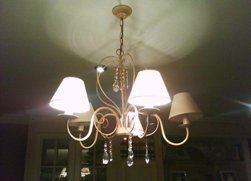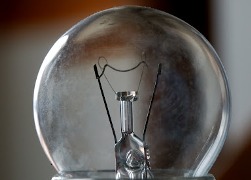Categories: Featured Articles » Electrician Secrets
Number of views: 90940
Comments on the article: 36
The lamp constantly burns in the same lamp. What is the matter and how to be?
About cases when the lamp constantly burns in the same lamp. On high starting currents in incandescent lamps, on transients and briefly on how to solve the problem.
 The flip of a switch: a light flashes in the toilet, momentarily illuminating the modest interior of the restroom, and that’s all. The light was bright, but not for long. Having figured out in the twilight with your natural needs, drag the stool, unscrew the affected lamp. She, of course, can no longer help.
The flip of a switch: a light flashes in the toilet, momentarily illuminating the modest interior of the restroom, and that’s all. The light was bright, but not for long. Having figured out in the twilight with your natural needs, drag the stool, unscrew the affected lamp. She, of course, can no longer help.
We screw in a new lamp, throw the incident out of our head. And the next day everything suddenly repeats: a click, a flash, and the sudden death of a lamp. What a disaster! Maybe the lamps are unsuccessful, defective? No way - in the corridor it burns exactly the same and without any excesses.
Remembering in vain both Ilyich and Edison, we stock up on light bulbs and reluctantly we exhaust our entire supply to a single lamp - all in the same toilet. And the lamps all burn out and burn out. And it is at the time of inclusion, that is, switching. Well, why, in the end?
In fact, when switching, any electrical equipment suffers, and not just light bulbs. Just the last luck less. The electrical resistance of their filament is very dependent on temperature, and during operation they warm up to more than two thousand degrees Celsius. At the same time, the nominal mode of operation of the lamp corresponds to a heated thread, which has a large resistance. When you turn on the cold spiral, the electric current can be ten times higher than the rated current due to reduced resistance. Figuratively speaking, after turning on the lamp receives a real electric shock of increased power.
Such strokes themselves are unpleasant and do not contribute to the long service life of the lamp and its filament. But the situation can be aggravated by another factor, due to which it turns out that it is in a particular lamp that lamps burn out with enviable constancy. This factor is transients during switching.
After all, the current through the bulb begins to flow immediately after applying voltage. And if the lamp, for example, has a power of 60 watts, then, considering the load is purely active, we conclude that the electric current should be approximately 0.27 amperes. It is in nominal mode. When you turn on the cold thread, all 2.7 amperes are already obtained. But how does the current change from zero to 2.7 amperes? Jumping, immediately after turning on the switch, or smoothly, after a while?
So, according to the theory of transients, the transition from a complete lack of current to 2.7 amperes can not be instantaneous. This, perhaps, is not surprising - after all, there are practically no instant processes in life, there are only processes that occupy very short periods of time from our human point of view. So the process of changing the electric current in the lavatory bulb takes thousandths, maybe hundredths of a second.
Here already, of course, our reasonings give a little philosophy, but the electric current also takes some time in order to accelerate to the speed of light. This is the first. And secondly, the presence / absence of reactive load affects the duration of transients in any circuit. So according to one of the laws of switching, inductor current physically cannot change instantly. The field created by the inductance will prevent the current from changing. And the greater the inductance, the slower the current will reach its steady-state, final value.
According to the second law of switching, the voltage on the capacitive element, that is, the capacitor, cannot sharply drop or increase.A capacitor needs time to give up or accumulate its charge. And the more its electric capacity, the more time will be required for changes.
These laws apply to both alternating and direct current circuits. But someone will say: “What other inductors and capacitors? It was about an ordinary light bulb - what did it have to do with it? ” Indeed, one could agree: after all, the reactance of an incandescent filament of a lamp is only a fraction of a percent of its active resistance. That is why the reactance of an incandescent lamp is neglected in the calculations.
But being neglected does not mean that it is absent. And in addition, the parameters of the entire chain, that is, the entire home network, cannot be thoroughly known to us. Only one thing can be said for sure: the equivalent circuit of an incandescent lamp will contain not only a resistor, but also a reactive element - a capacitor or inductor, and most likely - both at once.
When there are reactive elements in the circuit, the magnitude of the electric current in transients is defined as the sum of the established current and some kind of free component. The free component decreases very quickly after switching, and its maximum value occurs at the first moment after the circuit breaker is turned on.
The magnitude and duration of the action of the free component current, even in DC circuits, is determined by the method of solving complex differential equations that take into account the ratio of all parameters of the equivalent circuit - resistance, inductance and capacitance. In practice, such calculations are very rare - it is so difficult to determine all the parameters with sufficient accuracy.
 A light bulb in the toilet is included in the alternating current circuit, for which not only the equivalent circuit parameters play an important role, but also the initial phase of the circuit breaker. If the switch was turned on at a time when the voltage was at zero, the transient may not be noticeable in any way, and the lamp will go into operation under the most favorable conditions.
A light bulb in the toilet is included in the alternating current circuit, for which not only the equivalent circuit parameters play an important role, but also the initial phase of the circuit breaker. If the switch was turned on at a time when the voltage was at zero, the transient may not be noticeable in any way, and the lamp will go into operation under the most favorable conditions.
But if switching occurs when the voltage is at the peak of its value (and for a household network it is approximately 310 volts, by the way), then the bulb may be subjected to a current load that is twice the established value! Of course, given that the inductance and capacitance of the equivalent circuit will be small, the duration of such an overload will be very short. But the lamp is thus subjected to current shock due to the fact that the thread is not warmed up.
So, on the one hand, we have a cold filament, the resistance of which is small, and on the other hand, we have a circuit with unknown substitution parameters. And turn on this circuit is unknown at what point in time in the phase of the current. And if the magnitude of the reactive parameters of the circuit is of any significant importance, and the mains voltage is not lower than the nominal 220 volts, then the bulb will not be greeted.
Trying to find the real reason why lamps in this particular lamp constantly burn out is not a promising thing. After all, we cannot determine all the factors and parameters of the circuit and make the necessary corrections. Therefore, the problem is best solved radically.
The first possible solution is to change the type of lamp, or at least the lamp. For example, the same compact fluorescent lamps, known as energy-saving, are much less prone to the harmful effects of transients. And they have no incandescent filament - neither cold nor hot. The same can be said about LED lamps.
But if incandescent lamps are dear to you, and without their yellow-red light, "the light is not nice," you can do the following:
- install an electronic unit for protecting incandescent lamps. Such a unit not only provides a smooth supply of voltage to the lamp without inrush currents, but also stabilizes the voltage, ensuring optimal operation.
- install a throttle or active resistance in the lamp circuit, thereby lowering the voltage and providing the lamp with a softer mode of operation;
- install in the lamp circuit an ordinary diode corresponding to the rated current. The diode “cuts off” one half of the voltage period, and the lamp will burn twice as weak. For many places, for example, for a closet, or for a larger porch, it happens and is not necessary.
The last two ways to solve the problem are associated not only with a decrease in the brightness of the lamp, but also with the fact that it will work with less efficiency. But since we give preference to incandescent lamps, this fact should not really upset us.
Alexander Molokov
See also at bgv.electricianexp.com
:
